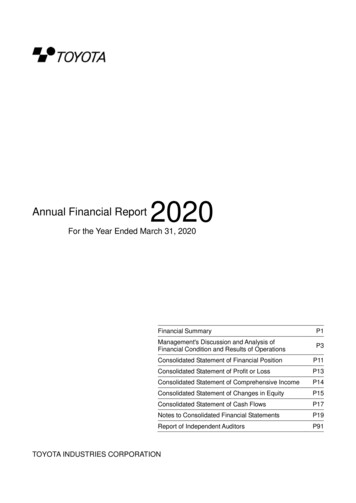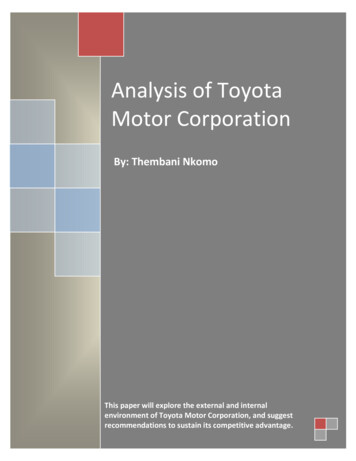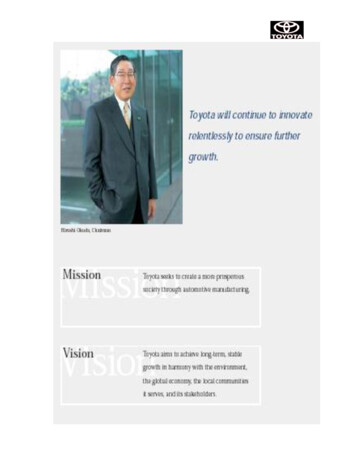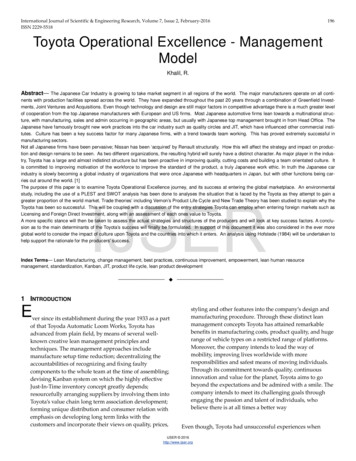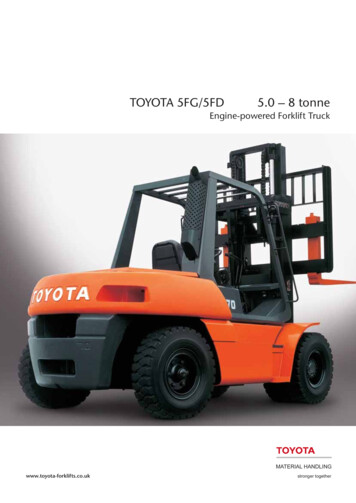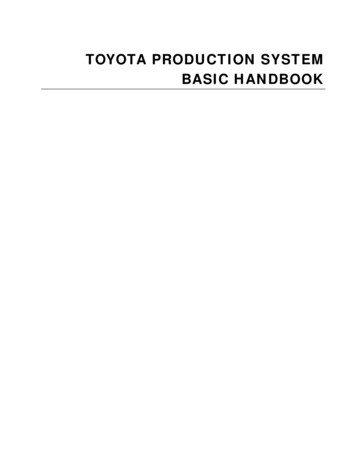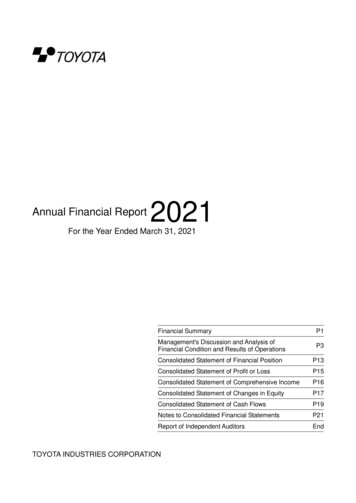
Transcription
Annual Financial Report2021For the Year Ended March 31, 2021Financial SummaryP1Management's Discussion and Analysis ofFinancial Condition and Results of OperationsP3Consolidated Statement of Financial PositionP13Consolidated Statement of Profit or LossP15Consolidated Statement of Comprehensive IncomeP16Consolidated Statement of Changes in EquityP17Consolidated Statement of Cash FlowsP19Notes to Consolidated Financial StatementsP21Report of Independent AuditorsEndTOYOTA INDUSTRIES CORPORATION
Financial SummaryToyota Industries Corporation and its consolidated subsidiaries IFRS 214,9462,171,3552,118,302Operating profit (Millions of yen)127,345147,445134,684128,233118,159Profit (Millions of yen)137,565173,816159,778150,187141,435Profit: attributable to owners of the parent(Millions of ve income (Millions of yen)202,743361,599(16,789)10,474854,098Share of equity attributable to ownersof the parent (Millions of otal assets (Millions of 12,788]66,947[11,396]Net sales (Millions of yen)Equity per share: attributable to ownersof the parent (Yen)Earnings per share-basic (Yen)Earnings per share-diluted (Yen)Ratio of equity attributable to ownersof the parent to total assets (%)Return on equity attributable to ownersof the parent (%)Price-to-earnings ratio (Times)Net cash provided by operating activities(Millions of yen)Net cash used in investing activities(Millions of yen)Net cash provided by financing activities(Millions of yen)Cash and cash equivalents at end of period(Millions of yen)Number of employees[Average number of part-time employees,not included in number of employees above](Notes) 1. Toyota Industries Corporation and its subsidiaries have adopted International Financial ReportingStandards ("IFRS") for the consolidated financial statements of the annual report.2. Net sales do not include consumption taxes.3. Amounts for diluted earnings per share are not presented because there are no shares with a potentiallydilutive effect.4. Number of employees is the number of workers (excluding people dispatched from the Group to outside theGroup, but including people dispatched from outside the Group to the Group).―1―
Japanese GAAP FY2017Net sales (Millions of yen)2,250,466Ordinary profit (Millions of yen)177,121Profit: attributable to owners of the parent(Millions of yen)125,534Comprehensive income (Millions of yen)198,548Total equity (Millions of yen)2,256,271Total assets (Millions of yen)4,428,644Equity per share (Yen)Earnings per share-basic (Yen)6,995.47402.00―Earnings per share-diluted (Yen)Equity-to-total assets ratio (%)49.04Return on equity (%)5.97Price-to-earnings ratio (Times)Net cash provided by operating activities(Millions of yen)Net cash used in investing activities(Millions of yen)Net cash provided by (used in) by financingactivities (Millions of yen)Cash and cash equivalents at end of period(Millions of yen)Number of employees[Average number of part-time employees,not included in number of employees 995](Notes) 1. Amounts for FY2017 are unaudited financial information pursuant to the first paragraph of Article 193-2 ofthe Financial Instruments and Exchange Act.2. Net sales do not include consumption taxes.3. Amounts for diluted earnings per share are not presented because there are no shares with a potentiallydilutive effect.4. Number of employees is the number of workers (excluding people dispatched from the Group to outside theGroup, but including people dispatched from outside the Group to the Group).―2―
Management's Discussion and Analysis of Financial Condition and Results of OperationsThe following Management's Discussion and Analysis of Financial Condition and Results of Operations is based oninformation known to management as of June 2021.This section contains projections and forward-looking statements that involve risks, uncertainties and assumptions. Youshould be aware that certain risks and uncertainties could cause the actual results of Toyota Industries Corporation and itsconsolidated subsidiaries to differ materially from any projections or forward-looking statements. These risks anduncertainties include, but are not limited to, those listed under "Risk Information" and elsewhere in this annual report.The fiscal year ended March 31, 2021 is referred to as FY2021 and other fiscal years are referred to in a correspondingmanner. All references to the "Company" herein are to Toyota Industries Corporation on a stand-alone basis andreferences to "Toyota Industries" herein are to the Company and its 256 consolidated subsidiaries.1. Result of Operations(1) Operating PerformanceIn FY2021 (ended March 31, 2021), the global economy declined sharply due to the spread of COVID-19. However,the economy has since bottomed out and begun to recover moderately thanks to factors such as the recuperatingChinese economy and underlying economic policies in respective countries. Although negatively affected by thedeclaration of a state of emergency, the Japanese economy is beginning to experience a moderate recovery as a resultof growth in exports mainly to China and robust consumer spending. In this operating environment, Toyota Industriesundertook efforts to ensure customer trust through a priority to quality as well as flexible response to market trends.Total consolidated net sales amounted to 2,118.3 billion yen, a decrease of 53.0 billion yen, or 2%, from the previousfiscal year.(2) Operating Performance Highlights by Business SegmentOperating results by business segment are as follows.Net sales for each segment do not include inter-segment transactions.(Automobile)The overall automobile market has shrunk despite recovery in the Chinese market. Amid such operating conditions, netsales of the Automobile Segment totaled 591.6 billion yen, a decrease of 22.2 billion yen, or 4%. Operating profitamounted to 4.7 billion yen, a decrease of 12.5 billion yen, or 72%, from the previous fiscal year.Within this segment, net sales of the Vehicle Business amounted to 88.3 billion yen, a decrease of 1.6 billion yen, or2%, owing to an increase in sales of RAV4 in Japan, offset by decrease internationally.Net sales of the Engine Business totaled 139.9 billion yen, an increase of 1.4 billion yen, or 1%, due to an increase insales of foundry products, offset by a decrease in sales of GD diesel engines and M20A gasoline engines.Net sales of the Car Air-Conditioning Compressor Business totaled 301.6 billion yen, a decrease of 26.6 billion yen, or8%, due primarily to a decrease of sales in North America and Europe.Net sales of Electronics Parts and Others Business totaled 61.6 billion yen, an increase of 4.5 billion yen, or 8%, due toan increase in sales of on board chargers.―3―
(Materials Handling Equipment)The materials handling equipment market recovered globally, led by China. Amid this operating climate, net sales of theMaterials Handling Equipment Segment totaled 1,431.4 billion yen, on par with the previous fiscal year. Sales of lifttrucks, a mainstay product of this segment, decreased primarily in Europe and North America despite an overallincrease to the net sales of the logistics solutions business. Operating profit amounted to 109.9 billion yen, an increaseof 7.7 billion yen, or 8%, from the previous fiscal year.(Textile Machinery)The textile machinery market continued its general decline. Net sales of the Textile Machinery Segment totaled 40.8billion yen, a decrease of 20.9 billion yen, or 34%, due mainly to a decrease in sales of weaving machinery and yarnquality measurement instruments. Operating loss amounted to 1.1 billion yen (operating profit of 2.9 billion yen in theprevious fiscal year).From FY2021, "the Electronics Parts, Foundry and Others Business" has been renamed as "the Electronics Parts andOthers Business", while foundry products and others included in "the Electronics Parts, Foundry and Others Business"have been reclassified into "the Engine Business" and "the Car Air Conditioning Compressor Business". Figures forFY2020 have also been reclassified.(3) Operating profitOperating profit for FY2021 was 118.1 billion yen, a decrease of 10.1 billion yen, or 8%, from the previous fiscal year.This was due mainly to a decrease in net sales and an increase in labor cost, partially offset by further advances incost reduction efforts throughout the Toyota Industries Group.(4) Profit before income taxesProfit before income taxes amounted to 184.0 billion yen, a decrease of 12.2 billion yen, or 6%, from the previous fiscalyear.(5) Profit attributable to owners of the parentProfit attributable to owners of the parent totaled 136.7 billion yen, a decrease of 9.1 billion yen, or 6%, from theprevious fiscal year.Earnings per share-basic was 440.28 yen compared with 469.85 yen in the previous fiscal year.2. Consolidated Financial ConditionTotal assets amounted to 6,503.9 billion yen, an increase of 1,224.3 billion yen from the end of the previous fiscal year,due mainly to an increase in fair value of investment securities. Liabilities amounted to 3,181.4 billion yen, an increase of422.3 billion yen from the end of the previous fiscal year. This was primarily because of an increase in deferred taxliabilities. Equity amounted to 3,322.5 billion yen, an increase of 802.0 billion yen from the end of the previous fiscal year.―4―
3. Liquidity and Capital Resources(1) Capital needs and returning profits to shareholdersToyota Industries' primary capital needs are twofold, specifically, long-term capital needs for research and development,capital investment, M&A and others as well as working capital needs for purchasing raw materials and parts formanufacturing the Group's products and for manufacturing costs and selling, general and administrative expenses.In addition to prioritizing fund allocation in research and development and capital investment, it is Toyota Industries'policy to invest funds in M&A and others when deemed necessary for business expansion and sustainable growth.As for returning profits to shareholders, it is determined to pay dividends at the consolidated dividend payout ratio ofaround 30%. In regard to dividend policy, refer to "7. Dividend Policy".(2) Financial policyToyota Industries' financial policy is to ensure sufficient financing for its business activities and to maintain sufficientliquidity and strong consolidated financial position. Toyota Industries continues to maintain its solid financial condition.Through the use of such current assets as cash and cash equivalents and short-term investments, as well as cashflows from operating activities, issuance of corporate bonds and loans from financial institutions, Toyota Industriesbelieves that it will be able to provide sufficient funds for the working capital necessary to expand existing businessesand develop new projects.Toyota Industries receives credit ratings from S&P Global Ratings Japan Inc., Moody's Japan K.K. and Rating &Investment Information, Inc. and strives to maintain and improve its ratings to procure funds at favorable terms.Regarding fund management, the Company undertakes integrated fund management of its subsidiaries in Japan, whileToyota Industries North America, Inc. (TINA) and Toyota Industries Finance International AB (TIFI) centrally managethe funds of subsidiaries in North America and Europe, respectively. Through close cooperation among the Company,TINA and TIFI, we strive to improve efficiency of funds operations.―5―
4. Cash FlowsNet cash provided by operating activities was 382.3 billion yen in FY2021, due to posting profit before income taxes of184.0 billion yen, and depreciation and amortization of 209.8 billion yen. Net cash provided by operating activitiesincreased by 69.2 billion yen compared to that of 313.1 billion yen in the previous fiscal year.Net cash used in investing activities was 404.1 billion yen in FY2021, attributable primarily to payments for bank depositsof 929.9 billion yen and payments for purchases of property, plant and equipment of 222.3 billion yen, which offsetproceeds from withdrawals of bank deposits of 752.4 billion yen. Net cash used in investing activities increased by 221.6billion yen compared to that of 182.5 billion yen in the previous fiscal year.Net cash used in financing activities was 105.4 billion yen in FY2021 due mainly to repayments of long term loans payableof 99.1 billion yen and repayments of corporate bonds of 84.5 billion yen, which outweighed proceeds from long term loanspayable of 182.2 billion yen. Net cash used in financing activities increased by 98.4 billion yen compared to that of 7.0billion yen in the previous fiscal year.After adding translation adjustments and cash and cash equivalents at beginning of period, cash and cash equivalents asof March 31, 2021 stood at 238.2 billion yen, a decrease of 119.9 billion yen, or 33%, from the end of the previous fiscalyear.5. Investment in Property, Plant and EquipmentDuring FY2021, Toyota Industries made a total investment of 252,959 million yen in property, plant and equipment(including materials handling equipment for operating lease) in order to launch new products, streamline and upgradeproduction equipment.The breakdown in the operating segments is as follows.In the Automobile Segment, investments in property, plant, and equipment was 85,475 million yen. This is primarilyattributable to the Company for 72,858 million yen. In the Materials Handling Equipment Segment, investments in property,plant, and equipment was 164,472 million yen. This is primarily attributable to Toyota Material Handling Europe AB Groupfor 45,685 million yen, Toyota Industries Commercial Finance, Inc. for 43,136 million yen, Raymond Group for 23,498million yen, Toyota Material Handling Australia Pty Limited for 14,280 million yen, Venderlande Group for 7,503 million yenand Nishina Industrial Co., Ltd. for 6,914 million yen. In the Textile Machinery Segment, investment in property, plant, andequipment was 628 million yen. In the Others Segment, investment in property, plant, and equipment was 2,383 millionyen.The fund is allocated from the Company's own resources, loans and corporate bonds.―6―
6. Strategies and OutlookCOVID-19 has induced dramatic changes affecting people's daily lives, including the widespread adoption of teleworkingand online communications as well as the expanded use of e-commerce. In the political, economic and technologicalareas as well, we have experienced the rise of nationalism, increased environmental wareness, and rapid digitization. Inthe markets for Automobile and Materials Handling Equipment, both of which constitute core businesses of ToyotaIndustries, competition among companies is intensifying, triggered by advancements in the fields of electrification andautonomous driving, new entrants that leverage digital technologies, and the transformation of the industrial structure. Inaddition, with a global supply shortage of semiconductors exposing potential risks and vulnerability in the supply chain aswell as other factors, the environment surrounding Toyota Industries precludes optimism.Under this circumstance, Toyota Industries has undertaken profit improvement activities and work style reforms, such asreviewing and deferring costs and capital investments as well as improving/eliminating certain work transactions. Lookingahead, we intend to focus on the following three actions in order to further strengthen the management platform andenhance corporate value.1) Thoroughly adhere to the basicsAdhere to basics such as safety, health, quality and compliance, which constitute the foundation of any company. We aimto place safety as our top priority and focuse on continuous improvements to quality and productivity.2) Strengthen management platformAt Toyota Industries, we regard change as opportunities for corporate growth. As such, we intend to promote a new form ofwork style that is free of conventional thinking and precedents. We intend to improve productivity by effectively utilizingdigital tools and implementing other measures. We will also strengthen our preparation for various risks and build a flexibleand robust organization so that we can make an agile response in emergency situations.3) Lay the groundwork for further growthTo capture changes in the markets and industries, we will develop innovative technologies and products by proactivelyutilizing digital technologies and open innovation in order to seize every opportunity for further growth.To support business development, we will continue our efforts to develop personnel who learn and think on their own andcould quickly take the initiative to create an organization and workplace environment that enables diverse humanresources to fully demonstrate their abilities.Through these initiatives, we aim for sustainable growth of each business and strive to support industries and socialfoundations around the world and contribute to making the earth a better place to live, enriched lifestyles and acomfortable society as described in Toyota Industries' Vision 2030.―7―
7. Dividend PolicyToyota Industries intends to meet the expectations of shareholders for continuous dividends while giving full considerationto business performance, funding requirements, the dividend payout ratio and other factors.Toyota Industries' Board of Directors meeting, held on April 30, 2021, approved a year-end cash dividend of 80.0 yen pershare. Including the interim cash dividend of 70.0 yen per share, cash dividends for the year totaled 150.0 yen per share.Toyota Industries will use retained earnings to improve the competitiveness of its products, augment production capacity inand outside Japan, as well as to expand into new fields of business and strengthen its corporate constitution in securingfuture profits for its shareholders.The Company's Articles of Incorporation stipulate that it may pay interim cash dividends as prescribed in Article 454-5 ofthe Companies Act and it is the Company's basic policy to pay dividends from retained earnings twice a year (interim andyear-end).The Company's Articles of Incorporation also stipulate that what is prescribed in Article 459-1 of the Companies Act can beadded to the Articles of Incorporation.―8―
8. Risk InformationThe following represent risks that could have a material impact on Toyota Industries' financial condition, business resultsand share prices. Toyota Industries judged the following as future risks as of March 31, 2021.(1) Principal CustomersToyota Industries' automobile and engine products are sold primarily to Toyota Motor Corporation ("TMC"). In FY2021,net sales to TMC accounted for 10.7% of consolidated net sales. Therefore, TMC's vehicle sales could have an impacton Toyota Industries' business results. As of March 31, 2021, TMC holds 24.7% of the Company's voting rights.(2) Product Development CapabilitiesBased on the concept of "developing appealing new products", Toyota Industries proactively develops new products byutilizing its leading-edge technologies, as it strives to anticipate increasingly sophisticated and diversifying needs of themarket and ensure the satisfaction of its customers.R&D activities are focused mainly on developing and upgrading products in current business fields and peripheralsectors. Toyota Industries expects that revenues derived from these fields will continue to account for a significantportion of total revenues and anticipates that future growth will be contingent on the development and sales of newproducts in these fields. Toyota Industries believes that it can continue to develop appealing new products. However,Toyota Industries may not be able to forecast market needs and develop and introduce appealing new products in atimely manner. This could result in lower future growth and have an adverse impact on Toyota Industries' financialcondition and business results.Such a situation could result from risks that include that there is no assurance that Toyota Industries will be able toallocate sufficient future funds necessary for the development of appealing new products; no assurance that productsales will be successful, as forecasts of products supported by the market may not always be accurate; and noassurance that newly developed products and technologies will always be protected as intellectual property.(3) Intellectual Property RightsIn undertaking its business activities, Toyota Industries has acquired numerous intellectual property rights, includingthose acquired outside Japan, such as patents related to its products, product designs and manufacturing methods.However, not all patents submitted will necessarily be registered as rights, and these patents could thus be rejected bypatent authorities or invalidated by third parties. Also, a third party could circumvent a patent of Toyota Industries andintroduce a competing product into the market. Moreover, Toyota Industries' products utilize a wide range oftechnologies. Therefore, Toyota Industries could become a party subject to litigation involving the intellectual propertyrights of a third party.(4) Product DefectsGuided by the basic philosophy of "offering products and services that are clean, safe and of high quality", ToyotaIndustries makes its utmost efforts to enhance quality.However, Toyota Industries cannot guarantee all its products will be defect-free and that product recalls will not bemade in the future. Product defects that could lead to large-scale recalls and product liability indemnities could result inlarge cost burdens and have a significant negative impact on the evaluation of Toyota Industries. It could also have anadverse effect on Toyota Industries' financial condition and business results due to a decrease in sales, deterioration ofprofitability and decrease in share prices of Toyota Industries.―9―
(5) Price CompetitionToyota Industries faces extremely harsh competition in each of the industries in which it conducts business, includingits Automobile and Materials Handling Equipment businesses, which are the core of Toyota Industries' earningsfoundation. Toyota Industries believes it offers high value-added products that are unrivalled in terms of technology,quality and cost.Amid an environment characterized by intensifying price competition, however, Toyota Industries may be unable tomaintain or increase market share against low-cost competitors or to maintain profitability. This could have an adverseimpact on Toyota Industries' financial condition and business results.(6) Reliance on Suppliers of Raw Materials and ComponentsToyota Industries' products rely on various raw materials and components from suppliers outside Toyota Industries.Toyota Industries has concluded basic business contracts with these external suppliers and assumes it can carry outstable transactions for raw materials and components. However, Toyota Industries has no assurances against futureshortages of raw materials and components, which arise from a global shortage due to tight supply or an unforeseenaccident involving a supplier. Such shortages could have a negative effect on Toyota Industries' production and causean increase in costs, which could have an adverse impact on Toyota Industries' financial condition and business results.(7) Environmental RegulationsIn view of its social responsibilities as a company, Toyota Industries strives to reduce any burden on the environmentresulting from its production processes, as well as strictly adheres to applicable environmental laws and regulations.However, various environmental regulations could also be revised and strengthened in the future. Accordingly, anyexpenses necessary for continuous strict adherence to these environmental regulations could result in increasedbusiness costs and have an adverse impact on Toyota Industries' financial condition and business results.(8) Alliances with Other CompaniesAiming to expand its businesses, Toyota Industries engages in joint activities with other companies through alliancesand joint ventures. However, a wildly fluctuating market trend or a disagreement between Toyota Industries and itspartners, owing to business, financial or other reasons, could prevent Toyota Industries from deriving the intendedbenefits of its alliances.(9) Exchange Rate FluctuationsToyota Industries' businesses encompass the production and sales of products and the provision of services worldwide.Generally, the strengthening of the yen against other currencies (especially against the U.S. dollar and the euro, whichaccount for a significant portion of Toyota Industries' sales) has an adverse impact on Toyota Industries' business, whilea weakening of the yen has a favorable impact. As such, in the businesses in which the Toyota Industries manufacturesproducts in Japan and exports them, the strengthening of the yen could reduce Toyota Industries' relative pricecompetitiveness on a global basis and have an adverse impact on Toyota Industries' financial condition and businessresults. To reduce such possibilities to a minimum, Toyota Industries uses, in principle, derivative transactions such asforward exchange contracts to hedge risks of exchange rate fluctuations.(10) Share Price FluctuationsToyota Industries holds marketable securities, and therefore bears the risk of price fluctuations of these shares. Basedon fair market value of these shares at the end of the fiscal year under review, Toyota Industries had unrealized gains.However, unrealized gains on marketable securities could worsen depending on future share price movements.Additionally, a fall in share prices could reduce the value of pension assets, leading to an increase in the pensionshortfall.― 10 ―
(11) Effects of Disasters, Power Blackouts and Other IncidentsToyota Industries carries out regular checks and inspections of its production facilities to minimize the effect ofproduction breakdown. However, there is no assurance Toyota Industries can completely prevent or lessen the impactof man-made or natural disasters and power blackouts occurring at Toyota Industries' and its suppliers' productionfacilities. Specifically, the majority of Toyota Industries' domestic production facilities and most of its business partnersare situated in the Chubu region. Therefore, major disasters in this region could delay or stop production or shipmentactivities. Such prolonged delays and stoppages could have an adverse impact on Toyota Industries' financial conditionand business results. To reduce such possibilities to a minimum, Toyota Industries works with business suppliers foroptimizing the supply chain such as obtaining alternative means of supplies of raw materials and parts by regionallydispersing channels.(12) Latent Risks Associated with International ActivitiesToyota Industries manufactures and sells products and provides services in various countries. Such unforeseen factorsas social chaos, including political disruptions, terrorism, wars and disease, as well as changes in economic conditions,could have an adverse impact on Toyota Industries' financial condition and business results.(13) Post-employment benefitsToyota Industries' defined benefit plan expenses and liabilities are calculated based on actuarial assumptions thatincorporate discount rates and other factors. Therefore, differences between actual results and assumptions, such as areduction in discount rates or a decrease in plan assets, as well as changes in the assumptions could have asignificant impact on recognized expenses and calculated liabilities in future accounting periods.9. Significant Contract AgreementsThere are no material significant contract agreements that need to be disclosed as of the end of fiscal year ended March31, 2021.― 11 ―
10. Toyota Industries' Relationship to Toyota Motor CorporationDue to historical reasons, Toyota Industries maintains close relationships with Toyota Motor Corporation ("TMC") andToyota Group companies in terms of capital and business dealings.(1) Historical BackgroundIn 1933, Kiichiro Toyoda, the eldest son of founder Sakichi Toyoda and then Managing Director of Toyoda AutomaticLoom Works, Ltd. (the present Toyota Industries), established the Automobile Department within the Company basedon his resolve to manufacture Japanese-made automobiles. In 1937, the Automobile Department was spun off andbecame an independent company, Toyota Motor Co., Ltd. (the present TMC).(2) Capital RelationshipIn light of this historical background, Toyota Industries and TMC have maintained a close capital relationship. As ofMarch 31, 2021, Toyota Industries holds 8.46% (238,466 thousand shares) of TMC's total shares in issue. Likewise, asof the same date, TMC holds 24.69% of Toyota Industries' total voting rights. Toyota Industries is a TMC affiliateaccounted for by the equity method.(3) Business RelationshipToyota Industries assembles certain cars and produces automobile engines under consignment from TMC. Additionally,Toyota Industries sells a portion of its other components and products directly or indirectly to other Toyota Groupcompanies. In FY2021, our net sales to TMC on a stand-alone basis accounted for 10.7% of our consolidated net sales.(4) Contributions to the Toyota GroupAs a member of the Toyota Group, Toyota Industries aims to contribute to strengthening the competitiveness of TMCand other Toyota Group companies in such area
This was due mainly to a decrease in net sales and an increase in labor cost, partially offset by further advances in cost reduction efforts throughout the Toyota Industries Group. (4) Profit before income taxes Profit before income taxes amounted to 184.0 billion yen, a decrease of 12.2 billion yen, or 6%, from the previous fiscal year.



